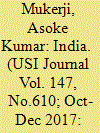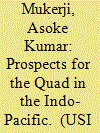| Srl | Item |
| 1 |
ID:
171729


|
|
|
|
|
| Summary/Abstract |
The League of Nations (LN) was conceptualized by the Treaty of Versailles,1
which formally ended the First World War on 28 June 1919. The Treaty also
created the International Labour Organization (ILO), a unique multi-stakeholder
multilateral structure in which policies are decided by governments, employers
and workers, without any government exercising veto power
|
|
|
|
|
|
|
|
|
|
|
|
|
|
|
|
| 2 |
ID:
182218


|
|
|
| 3 |
ID:
166050


|
|
|
| 4 |
ID:
158616


|
|
|
| 5 |
ID:
164245


|
|
|
|
|
| Summary/Abstract |
India-Japan collaboration in the Indo-Pacific had its origins more than a decade ago in the concept of the “confluence of the two seas” proposed by Prime Minster Shinzo Abe of Japan in India’s Parliament in 2007. Since then, the two countries have articulated a holistic framework for the Indo-Pacific, defining it to include both the Indian and the Pacific Oceans. They have announced an integrated Indo-Pacific strategy in which the rule of international law, maritime security, technology, connectivity and the increased participation of Africa play a prominent role. The collaboration between India and Japan, two declared candidates for permanent membership of a reformed UN Security Council, in the Indo-Pacific will have significant consequences both for their bilateral relationship as well as the wider region.
|
|
|
|
|
|
|
|
|
|
|
|
|
|
|
|
| 6 |
ID:
166125


|
|
|
|
|
| Summary/Abstract |
Prospects for the Quadrilateral Security Dialogue (Quad) amongst Australia, India, Japan and the United States have been the focus of increased attention following the identification of an Indo-Pacific strategic framework, which has been endorsed by the four countries. The centrality of ASEAN in the Indo-Pacific has been emphasised by the Quad. To take the dialogue forward, the Quad needs to urgently converge existing divergences regarding their individual definitions of the Indo-Pacific. Equal participation of all four Quad countries in maritime security cooperation is crucial for a Free and Open Indo-Pacific region. Three issues which require priority attention for realising the full potential of the Quad are the identification of a common framework of international law to uphold a “rules-based order”; implementing connectivity projects with a view to integrating the hinterland of land-locked states of Asia and Africa into the Indo-Pacific region; and integrating the security of all the major sea lanes of communication in the broad Indo-Pacific region into the Quad’s strategic footprint. This will require upholding the principle of international cooperation, so that the Quad can contribute constructively to securing an inclusive Indo-Pacific at a time of increased great power rivalry.
|
|
|
|
|
|
|
|
|
|
|
|
|
|
|
|
| 7 |
ID:
173679


|
|
|
| 8 |
ID:
159640


|
|
|
| 9 |
ID:
164117


|
|
|
|
|
| Summary/Abstract |
Anew strategic dynamic between the United States (US), China and Russia in contemporary international affairs has emerged over the past few years. The process began more than five years ago with the US applying new domestic laws extra-territorially to impose sanctions against Russia (on account of alleged corrupt practices) and Crimea. The emergence of a new assertive China under President Xi Jinping catalysed this process further.1 With the election of President Donald Trump in the US presidential elections in 20162, the strategic dynamic between the three powers has been marked by disruptions in their interaction. This has resulted in a gridlock in international relations, with each of the three powers acting within their individual strategic frameworks to derive advantage over the other. Inevitably, this interaction has major ramifications for the system of international relations founded on the principle of international cooperation established almost a century ago after the First World War. To assess this complex interplay, it would be useful to look at the strategic drivers of the bilateral equations between the US and Russia, the US and China, and China and Russia.
|
|
|
|
|
|
|
|
|
|
|
|
|
|
|
|